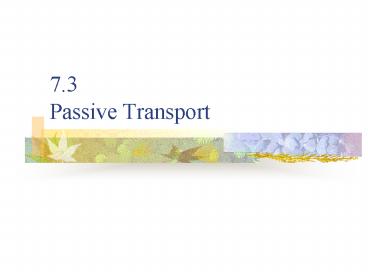7'3 Passive Transport - PowerPoint PPT Presentation
1 / 38
Title:
7'3 Passive Transport
Description:
Def: the process by which water molecules diffuse across a cell membrane from an area of high concentration to an area of lower concentration ... – PowerPoint PPT presentation
Number of Views:38
Avg rating:3.0/5.0
Title: 7'3 Passive Transport
1
7.3Passive Transport
2
Passive Transport
- Homeostasis is very important to a cells vitality
- Cells are going to need to move substances into /
out of the cell - Process called passive transport
- REQUIRES NO ENERGY
3
Types of Passive Transport
- Diffusion
- Osmosis
- Facilitated Diffusion
- Diffusion through Ion Channels
4
Diffusion
- Def The movement of molecules from an area of
higher conc. (concentration) to an area of lower
conc. - Simplest type of passive transport
- The differences in the concentration is called
the concentration gradient
5
(No Transcript)
6
Diffusion-
- If there are no outside influences the solute
will reach equilibrium - Def when the concentration of molecules of a
substance is the same throughout.
7
Diffusion and the Cell Membrane
- The ability of a molecule to diffuse across a
membrane depends on the size and type of the
molecule and the chemical nature of the membrane - ie hydrophobic and hydrophilic substances
8
(No Transcript)
9
Osmosis-
- Def the process by which water molecules diffuse
across a cell membrane from an area of high
concentration to an area of lower concentration
10
Direction of Osmosis
- When the concentration of the solute is Higher on
the outside of the cell than in the cytoplasm the
cells is said to be Hypertonic - Water will rush out of the cell
- When concentration of solute is Lower on the
outside of the cell than in the cytoplasm the
cell is Hypotonic - Water will rush into the cell
11
(No Transcript)
12
(No Transcript)
13
Hypotonic, Hypertonic, Isotonic
- Hypotonic- water rushes into the cell
- Cell swells. If it swells too much it could
explode - Hypertonic water rushes out of the cell
- Cell shrinks and appears to have spikes
- Isotonic- the concentrations on both sides of the
cell are equal thus there is no net movement - Cell remain original shape
14
(No Transcript)
15
Isotonic
16
Hypotonic
17
Hypertonic
18
19
(No Transcript)
20
Turgor Pressure
- The pressure that water exerts on the cell walls
- In hypertonic solution there is little waterso
there is little pressure exerted on the cell
wallsplant wilts
21
(No Transcript)
22
Turgor Pressure
23
Facilitated Diffusion
- The process of substances moving down the
concentration gradient with the assistance of a
carrier protein - Requires NO ENERGY and each carrier molecule is
SPECIFIC for a certain molecule
24
(No Transcript)
25
Ion Channels
- A membrane protein that provides a passageway
across the cell membrane for ions to pass
through. Each channel is for a certain ion only.
26
Active Transport
27
Active Transport
- Requires energy.
- Two types
- Cell Membrane Pumps
- Endo/Exocytosis
28
Cell Membrane Pumps
- Moves substances up the conc. Gradient
- From an area of low to high
- Sodium-Potassium Pump
- Pumps Sodium out of the cell and (Na)
- Pumps Potassium into the cell (K)
- 3 Na ions pumped out with the use of ATP and on
the return 2 K come into the cell - As result electrical gradient is produced
- Example Muscles
29
(No Transcript)
30
(No Transcript)
31
(No Transcript)
32
Exocytosis Endocytosis
- Some molecules are too large to enter
- Requires Energy
- Endo-into
- Exo- out of
33
Endocytosis
- Cells ingest macromolecules
- The cell folds on itself and engulfs the
substances the macromolecules are surrounded by
membranes - Pinocytosis- contains solutes or fluids
- Phagocytosis- contains large particles or cells
34
(No Transcript)
35
Exocytosis
- Vesicles in the cytoplasm fuse with the cell
membrane, releasing their contents into the
cells external environment - Usually wastes or proteins that were made on the
cells ribosomes
36
(No Transcript)
37
(No Transcript)
38
(No Transcript)































